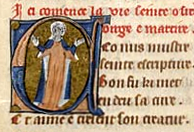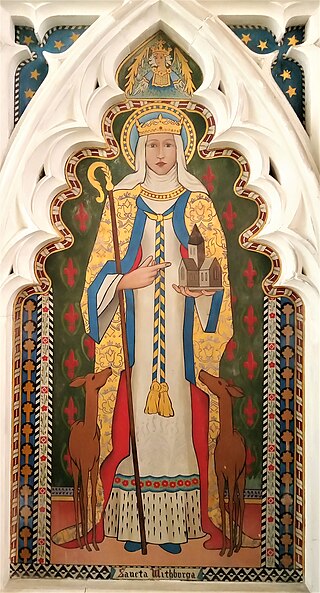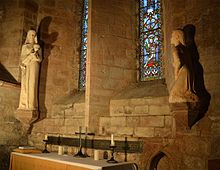
Oswald was King of Northumbria from 634 until his death, and is venerated as a saint, of whom there was a particular cult in the Middle Ages.

Saint Brigid of Kildare or Saint Brigid of Ireland is the patroness saint of Ireland, and one of its three national saints along with Patrick and Columba. According to medieval Irish hagiographies, she was an abbess who founded the important abbey of Kildare, as well as several other convents of nuns. There are few historical facts about her, and her hagiographies are mainly anecdotes and miracle tales, some of which are rooted in pagan folklore. They say Brigid was the daughter of a chieftain and a slave woman, and was raised in a druid's household before becoming a consecrated virgin. She is patroness of many things, including poetry, learning, healing, protection, blacksmithing, livestock and dairy production. In her honour, a perpetual fire was kept burning at Kildare for centuries.

Osgyth was a Mercian noblewoman and prioress, venerated as an English saint since the 8th century, from soon after her death. She is primarily commemorated in the village of St Osyth, in Essex, near Colchester. Alternative spellings of her name include Sythe, Othith and Ositha. Born of a noble family, she became a nun and founded a priory near Chich which was later named after her.

Werburgh was an Anglo-Saxon princess who became the patron saint of the city of Chester in Cheshire. Her feast day is 3 February.

Hilda of Whitby was a saint of the early Church in Britain. She was the founder and first abbess of the monastery at Whitby which was chosen as the venue for the Synod of Whitby in 664. An important figure in the Christianisation of Anglo-Saxon England, she was abbess in several convents and recognised for the wisdom that drew kings to her for advice.

A double monastery is a monastery combining separate communities of monks and of nuns, joined in one institution to share one church and other facilities. The practice is believed to have started in the East at the dawn of monasticism. It is considered more common in the monasticism of Eastern Christianity, where it is traceable to the 4th century. In the West the establishment of double monasteries became popular after Columbanus and sprang up in Gaul and in Anglo-Saxon England. Double monasteries were forbidden by the Second Council of Nicaea in 787, though it took many years for the decree to be enforced. Double monasteries were revived again after the 12th century in a significantly different way when a number of religious houses were established on this pattern among Benedictines and possibly the Dominicans. The 14th-century Bridgittines were purposely founded using this form of community.

Saint Everild of Everingham was an Anglo-Saxon saint of the 7th century who founded a convent at Everingham, in the English county of the East Riding of Yorkshire. All we know of her comes from the York Breviary.

Saint Faith or Saint Faith of Conques is a saint who is said to have been a girl or young woman of Agen in Aquitaine. Her legend recounts how she was arrested during persecution of Christians by the Roman Empire and refused to make pagan sacrifices. Saint Faith was tortured to death with a red-hot brazier. Her death is sometimes said to have occurred in the year 287 or 290, sometimes in the large-scale Diocletianic Persecution beginning in 303. She is listed as "Sancta Fides, Virgin and martyr", in the martyrologies.

St Bees is a coastal village, civil parish and electoral ward in the Copeland district of Cumbria, England, on the Irish Sea.
Christianity in medieval Scotland includes all aspects of Christianity in the modern borders of Scotland in the Middle Ages. Christianity was probably introduced to what is now Lowland Scotland by Roman soldiers stationed in the north of the province of Britannia. After the collapse of Roman authority in the fifth century, Christianity is presumed to have survived among the British enclaves in the south of what is now Scotland, but retreated as the pagan Anglo-Saxons advanced. Scotland was largely converted by Irish missions associated with figures such as St Columba, from the fifth to the seventh centuries. These missions founded monastic institutions and collegiate churches that served large areas. Scholars have identified a distinctive form of Celtic Christianity, in which abbots were more significant than bishops, attitudes to clerical celibacy were more relaxed and there were significant differences in practice with Roman Christianity, particularly the form of tonsure and the method of calculating Easter, although most of these issues had been resolved by the mid-seventh century. After the reconversion of Scandinavian Scotland in the tenth century, Christianity under papal authority was the dominant religion of the kingdom.

Wihtburh was an East Anglian saint, princess and abbess. According to tradition, she was the youngest daughter of Anna, king of the East Angles, but Virginia Blanton has suggested that the royal connection was probably a fabrication. One story says that the Virgin Mary sent a pair of female deer to provide milk for Wihtburh's workers during the construction of her convent at Dereham, in Norfolk. When a local official attempted to hunt down the does, he was thrown from his horse and killed.

Saint Gobnait, also known as Gobnat or Mo Gobnat or Abigail or Deborah, is the name of an early medieval female Irish saint whose church was Móin Mór, later Bairnech, in the village of Ballyvourney, County Cork in Ireland. She is associated with the Múscraige and her church and convent lay on the borders between the Múscraige Mittine and Eóganacht Locha Léin. Her feast day is February 11.

Egremont Castle is located in the town of Egremont, Cumbria.
Saint Edith of Polesworth is an Anglo-Saxon abbess associated with Polesworth (Warwickshire) and Tamworth (Staffordshire) in Mercia. Her historical identity and floruit are uncertain. Some late sources make her a daughter of King Edward the Elder, while other sources claim she is the daughter of Egbert of Wessex. Her feast day is 15 July.
Kyneburga, Kyneswide and Tibba were female members of the royal family of Mercia in 7th-century England. They are venerated as saints.

St. Begnet, also Begneta, Begnete, Begnait or Becnait is a patron saint of Dalkey, Ireland. She is noted as a "virgin, not a martyr." Her feast day is November 12. Two ruined churches in Dalkey are named for Begnet, one on Dalkey Island, and the other near the 14th-century stone townhouse now serving as Dalkey Castle and Heritage Centre, in the area known as Kilbegnet. A holy well located near the martello tower on the island is also associated with her; as the Irish playwright Hugh Leonard observed:
A few yards away are the ruins of a church supposedly built by the town's patron saint, St. Begnet. Like St. Patrick himself, St. Begnet may never have existed: There is even uncertainty as to whether he or she was male or female. No one bothers to argue about this: In Dalkey, when it is a question of sainthood, sex is hardly likely to have much relevance.

St Bees Priory is the parish church of St Bees, Cumbria, in England. There is evidence for a pre-Norman religious site, and on this a Benedictine priory was founded by the first Norman Lord of Egremont William Meschin, and was dedicated by Archbishop Thurstan of York, sometime between 1120 and 1135.
Osburh was a Saint in Coventry, probably Anglo-Saxon but see below. Nothing about her life has survived to the present day. Her mortal remains were enshrined at Coventry. Close to the Forest of Arden, Coventry was at that time a tiny settlement.

The history of medieval Cumbria has several points of interest. The region's status as a borderland coping with 400 years of warfare is one. The attitude of the English central government, at once uninterested and deeply interested, is another. As a border region, of geopolitical importance, Cumbria changed hands between the Angles, Norse, Strathclyde Brythons, Picts, Normans, Scots and English; and the emergence of the modern county is also worthy of study.
St Bega's Way is a 36-mile (58 km) walk through rural West Cumbria and the north west corner of the English Lake District. It is usually completed as a leisure walk over 3 days, but has also been used as the basis of a single day competitive Ultramarathon.

















